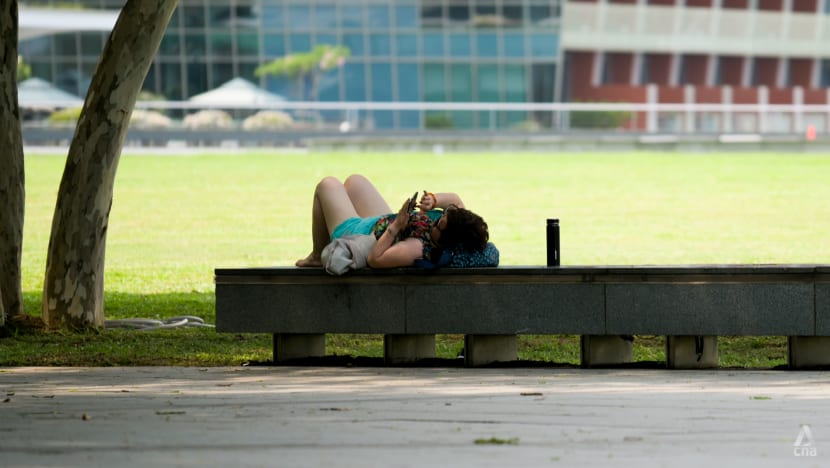Commentary: As temperatures rise, we must rethink how we stay cool
We need smarter approaches to minimise the impact of heat on our health and daily activities, says Fabian Lim of NTU.

A woman coolsΒ off under a tree during a spell of hot weather in Singapore. (Photo: Calvin Oh)

This audio is generated by an AI tool.
SINGAPORE: From blistering summers to raging wildfires, many countries are experiencing higher temperatures more frequently and for longer parts of the year. Besides taking steps to prevent global warming, we must also learn to cope with a hotter environment.
By 2100, Singapore may see daily maximum temperatures exceed 35 degrees Celsius for up to 351 days per year. Presently, such peak temperatures are recorded occasionally in the hotter months of May to July each year.
Being in the tropics, we also have to cope with a higher level of humidity, which impedes heat removal from the body to the environment. The combination of heat and humidity not only poses health risks, but also significantly reduces productivity, particularly for those working outdoors or in non-air-conditioned environments.
Research conducted by the Yong Loo Lin School of Medicine indicates that companies lose approximately S$21 (US$16) per worker per hot day due to decline in productivity. When scaled up across the labour force, this amounts to S$2.2β―billion in annual economic losses by 2035 if current warming trends persist. These findings show that the impact of heat is not just physiological, but also economic.
BUILDING RESILIENCE IN OUR PHYSIOLOGY
The mechanisms that regulate body temperature can adapt to manage a greater heat load through heat acclimatisation. This process involves gradual and daily exposure to a hot environment.
For most healthy individuals, heat acclimatisation may start from 20 to 30 minutes of walking at normal pace during the warmer part of the day and increasing in duration to 1 to 2 hours over 10 to 14 days.
Water should be consumed freely during the walk and the duration of walk should be based on individual physical ability, without causing symptoms of over-exertion such as heavy panting, exhaustion or dizziness.
There is evidence that heat acclimatisation brings about increased physical performance and lower body temperature when carrying out the same tasks.
ADJUSTING DAILY ROUTINES
Around the world, people are adjusting their daily routines to cope with rising heat. Cambodia has shortened school days by two hours to help children avoid peak daily temperature, and Spain and several Gulf states prohibit outdoor work during midday.
Across Europe and the Middle East, work and leisure are increasingly scheduled around cooler periods of the day. Early gym sessions and late-night construction are becoming more common. In a recent paper, I described this trend as a shift towards a semi-nocturnal lifestyle, where activities take place before sunrise and after sunset to avoid midday heat.
Another strategy is imposing a work-rest ratio for those working outdoors. This allows time for the body to cool so that the next cycle of work starts at a lower body temperature.
In occupational settings, the general work-rest ratio is around 45 to 60 minutes of work to 15 to 20 minutes of rest, though this depends on the duration and intensity of the activity, profile of workers and environmental conditions. Taking showers or wiping the body with a towel soaked in cold water can add to heat removal during rest intervals.
INFRASTRUCTURE AND TECHNOLOGY
Shade is especially useful in shielding pedestrians from the hottest part of the day. Outdoor shade is plentiful in Singapore because of its history of landscaping walking paths with trees and building sheltered walkways.
Urban planners could take this a step further by viewing shelters and pathways as one entity. Under this concept, the construction of walking path is not complete until it is also sheltered. Singaporeβs small geographical size makes this strategy more manageable.
The provision of cooling spots in public spaces will allow people to seek reprieve from the heat. Air-conditioned buildings can serve as cooling spots. In parks and industrial areas, air-conditioned βcooling podsβ can be provided.
Singapore has made promising progress in passive cooling. Heat-reflective roof coatings and cooling paints, which can lower the surface temperature of buildings, such as the ones deployed on HDB blocks, can help reduce indoor heat without additional energy consumption.
The fan is not as effective for body cooling when air temperature exceeds skin temperature (above 35 degrees Celsius). More viable solutions are likely to come from personal body cooling, air-conditioning and self-cooling clothing materials. Devices that cool the body rather than indoor spaces are promising due to their smaller carbon footprint, given the need to reduce emissions to avert the climate crisis.
However, these technologies are still in their early stages due to limitations in energy supply, mobility and capacity for heat removal. They would need further development to be ready for mass production.
If we want to stay safe and productive in a rapidly warming world, we must rethink not just how we cool ourselves, but also how we organise our daily activities, design our buildings, and care for the vulnerable, particularly children and the elderly. Climate adaptation is urgent, and the time to act is now.
Dr Fabian Lim, a pioneer in thermoregulation and heat injury research in Singapore, is Senior Lecturer at the Lee Kong Chian School of Medicine, Nanyang Technological University.











